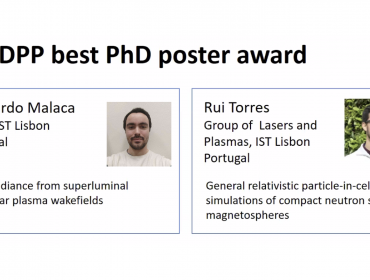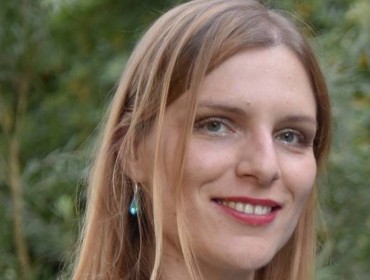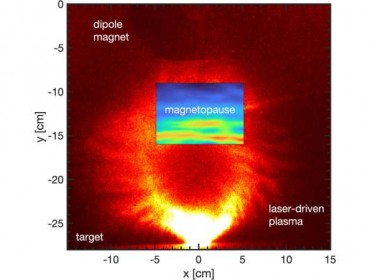-
EPP team members receive 71 million core hours at LUMI supercomputer
Read moreEuroHPC awarded 71 million core hours to the epp team to investigate compact plasma accelerators and light sources. A 37 million core-hours allocation on the LUMI supercomputer (Finland) was awarded to Jorge V. (co-PI Thales S.) to explore extreme acceleration and radiation in plasma accelerators. A 34 million core-hours allocation was awarded to Marija V. (co-PI Bertrand M.) for the project PARIS: Particle Acceleration and Radiation with Intense laser Systems.
October 19, 2022 -
IST Distinguished Lecture by Sergei Bulanov
Read moreOn Friday, 10th of November at 11:30 am, there will be an IST Distinguished Lecture by Sergei Bulanov (FZU – Institute of Physics of the Czech Academy of Sciences). The event will take place at Anfiteatro Abreu Faro – Complexo I at IST.
Title: Extreme Light–Matter Interaction through the Lenses of the Relativistic Flying Mirror Concept
Abstract: In his seminal paper published in 1905, A. Einstein used an example of the light reflection from the mirror moving with arbitrarily large velocity to illustrate basic principles of special theory of relativity. Nowadays the electromagnetic field intensification and the frequency upshift during the light reflection from the relativistic mirror are attractive for research on the development of sources of high-brightness radiation with tunable parameters required by various applications ranging from relatively moderate radiation intensity and ending with those devoted to quantum field theory. In this regard emerges a question on whether or not it is possible to prepare…
October 13, 2022 -
EPP team member Óscar A attended ICUIL IBS Conference on Ultrahigh Intensity Lasers 2022 (South Korea)
Read moreEPP team member Óscar Amaro went to Jeju Island in South Korea to attend the 2022 edition of the ICUIL IBS Conference on Ultrahigh Intensity Lasers, held on 18-23 September 2022, and deliver a talk. The work presented there consisted in recent developments of a simplified approach to theoretical modelling of electron-laser scattering experiments. The conference included, among other topics, progress in the commissioning of several high intensity laser facilities, some of which will begin user calls soon and run experiments to test strong field quantum electrodynamics.
More information about the conference here.
October 1, 2022 -
EPP team members attend EuroNNAc Special Topics Workshop
Read moreEPP team members Chiara Badiali, Bertrand Martinez and Mariana Moreira (all in the picture above) went to Isola d’Elba in Italy to attend the 2022 edition of the EuroNNAc Special Topics Workshop, held on 18-24 September 2022.
Bertrand M and Mariana M delivered talks, whereas Chiara B presented a poster about their recent work.
September 26, 2022 -
Marija Vranic Wins the 2022 IUPAP award for plasma physics
Read moreThe EPP member Marija Vranic, is the winner of the 2022 International Union of Pure and Applied Physics (IUPAP) Early Career Award for the Comission on Plasma Physics. The recognition is awarded for her contributions on the understanding of the interplay between classical and quantum effects in extreme ultra-intense laser-plasma interactions, on the underlying computational methods, and on the applications for plasma-based secondary sources of energetic particles. This is the first time an IUPAP prize is given to someone working in Portugal.
July 12, 2022 -
LPAW’23 organized by GoLP, more information coming soon
Read moreGoLP is organizing the 2023 Laser and Plasma Accelerator Workshop (LPAW’23) to be held March 6-10, 2023, in Lagos, Portugal. Stay tuned for more information coming soon here.
July 8, 2022 -
EPP members Bernardo Malaca and Rui Torres awarded EPS-DPP Poster Prizes 2022
Read moreAt the closing session of the 48th EPS Plasma Physics Conference (fully virtual), the posters of Rui Torres and Bernardo Malaca were announced as winners of the EPS-DPP best poster awards 2022. They received this award presenting the work with the title “General relativity particle-in-cell simulations of compact neutron star magnetospheres” and “Superradiance from superluminal nonlinear plasma wakefields”.
July 1, 2022 -
Upcoming MRE Webinar with the EPP member Marija Vranic
Read moreOn June 14th, 2022, 9 am EDT (2 pm WET), our EPP member Marija Vranic will present at a Matter and Radiation at Extremes (MRE) webinar.
MRE is committed to publishing original and impactful research and review papers that address extreme states of matter and radiation, and the associated science and technology employed to produce and diagnose these conditions in the laboratory. Drivers, targets and diagnostics are included along with related numerical simulation and computational methods. It aims to provide a peer-reviewed platform for the international physics community and promote worldwide dissemination of the latest and impactful research in related fields.
For more information, and for the link to the webinar with the title Plasma in extreme fields: challenges and opportunities, which is free and open to the public, please click here.
June 13, 2022 -
Training event on “Modelling of ultra-intense laser propagation in plasmas and laser-plasma accelerators: fundamentals” organized by GoLP
Read moreFor PhD students/post-docs/researchers in laser-plasma interactions, this training event is dedicated to the fundamentals of computational modeling of intense laser pulse propagation in plasma, and applications to compact laser plasma-based accelerators. Laser plasma accelerators are one of the most exciting applications of intense lasers and computational modeling plays a critical role in the design and optimization of laser plasma accelerators.
The event, organized in collaboration with Laserlab, takes place over the course of 4 days, with a 2 hour lecture per day where participants will learn the basics of pulse propagation in plasma, and the principles of state-of-the-art laser-plasma computational tools, how to use these tools and perform data analysis.
The computational tool to be used is ZPIC, complemented by Jupyter notebooks. It is a fully relativistic, electromagnetic, and open-source particle-in-cell code. ZPIC builds on the state-of-the-art particle-in-cell OSIRIS, and it features all the basic ingredients of the particle-in-cell scheme without…
April 27, 2022 -
Modeling Earth’s magnetosphere in the laboratory in Physics of Plasma
Read moreIn Physics of Plasmas, a collaboration of scientists from Princeton, UCLA, and Instituto Superior Técnico, reports a method to study smaller magnetospheres, sometimes just millimeters thick, in the laboratory.
A magnetized object, such as our planet Earth, is immersed within a stream of ionized gas, called plasma. The region around the object in which this effect is seen is called a magnetosphere.
The Earth’s large magnetosphere that extends out into space, has also the fundamental role of blocking lethal cosmic rays and particles from the sun and stars and allowing life itself to exist.
These mini-magnetospheres have been observed around comets and near-certain regions of the moon and have been suggested to propel spacecraft. They are good testbeds for studying larger planet-sized magnetospheres.
Previous laboratory experiments have been carried out utilizing plasma wind tunnels or high-energy lasers to create mini-magnetospheres. However, these earlier experiments were limited to 1D measurements of magnetic fields that…
April 15, 2022
extreme plasma physics > News


















